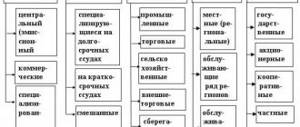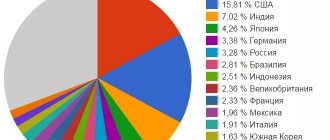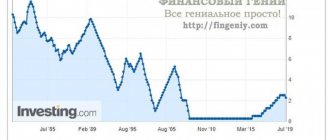The rate of economic progress of the People's Republic of China is increasing. The country is one of the world leaders in the level of development of many sectors of the economy, science, and technology. Banks in China are also distinguished by their high achievements. In 2021, the Chinese banking system was recognized as the largest on the planet: the volume of assets held by its banking institutions exceeded the assets of European banks by $2 trillion. Four of the world's largest banks are Chinese state-owned. The country is represented by 18 banking institutions in the top 100 banks in the world.
Banking system of the country
The Chinese banking system is divided into three main levels:
- First-rank banks include the People's Bank of China, which is the Central Bank of the People's Republic of China, and 3 political banks: China Development Bank, Agricultural Development Bank of China and China Exim Bank. The general function of level 1 is to control financial flows, manage development funds, and issue money.
- The second rank is occupied by state financial and credit organizations, which are the most reliable. These include the Big Chinese Four.
- The third rank is private organizations, with much lower profitability and own assets. This also includes post offices and small credit cooperatives.
State and joint-stock banks
Banking structures operating under the auspices of the state carry out mainly foreign economic activities. In this regard, they often cooperate with Sberbank and the Central Bank, open representative offices around the world (including in Moscow) and are, in fact, joint-stock companies.
The Chinese government always maintains control over its financial structures, holding a majority stake. This form of organization makes it possible to prohibit undesirable actions, and the banks themselves can continue to carry out monetary activities.
To this end, legislation was reformed at one time, introducing significant changes to China’s payment systems. New laws allow citizens of different countries to take out consumer loans, mortgages, make payments for services and deposits, process documents, etc.
"Big Four"
The four largest banks in China, called the “Big Four”:
- ICBC (Industrial and Commercial Bank of China);
- CCB (Construction Bank of China);
- The Agricultural Bank of China (Agricultural Bank of China);
- Bank of China (Bank of China).
They are the main banks in China in terms of assets. They occupy leading positions both in the country and throughout the world. Using their enormous financial capabilities, they increase capital by investing and issuing loans. They have branches and subsidiaries all over the world. Chinese banks in Russia are represented only by Bank of China. Its branch is the Bank of China (ELOS) network. In Russia, Elos does not have such high ratings because it is focused on securing trade deals for Chinese firms.
To summarize the above
China has an extensive banking system consisting of three levels. The idea that all banking institutions in this country are state-owned is erroneous. A large number of private commercial banks operate here. The main feature of the Chinese banking system is that the activities of all financial institutions are strictly controlled by the state.
Chinese banks provide services to foreigners. Thus, non-residents can open an account in a Chinese bank, receive an international money transfer, or take out a loan or mortgage. Foreigners working in China under an employment contract have the right to receive their salary on a Chinese bank card. And not only in yuan, but also in foreign currency.
Foreign representative offices and branches
Some foreign branches are over thirty years old. The peak of their active development was the nineties and the beginning of the two thousandth, shortly after the country joined the World Trade Organization.
According to the China Banking Regulatory Commission, the number of representative offices grew fastest in the period from 2004 to 2007, when it reached 274. The same with the number of total assets and the volume of foreign capital in the Chinese banking sector in percentage terms. If in 2004 this figure was 1.8%, then by 2007 it was already 2.38%. To control competition in the industry, a number of strict restrictions and requirements have been introduced since 2008. This brought with it the expected slowdown in the pace of development. So in 2012, the assets of foreign branches in the economy returned to 1.82% of the total.
Now that the positions of national banks have already strengthened, the onset of a liberalization policy is predicted with the gradual lifting of restrictions for foreigners.
Third category
China's small banks and cooperatives have been created to reduce the number of money lenders, who until recently were abundant in China. They serve small and medium businesses. Their branches operate in post office buildings.
Recently, Russian analysts have been talking about an emerging trend of using Chinese experience in our country. Today there is an active development of monopolists, whose capitals include state assets. Undesirable players leave the market. For example, Bank Ugra. Its head office was located in Kitai-Gorod.
Russian banks in China
Russia is represented by such banks as:
- Sberbank;
- Gazprombank;
- VTB;
- Promsvyaz;
- Central Bank of the Russian Federation.
However, despite the seemingly impressive list, Russian banks in China are not focused on the country’s domestic market, but are opened to service representative offices of Russian companies and trade turnover between countries. Many banks do not even have the license necessary to carry out banking operations. Others are content to merely carry out import and export obligations. Apart from Russia, no other CIS country in the region has opened its branches in China.
By the end of 2021, the Chinese banking system has already become the largest in the world. According to a Financial Times study, China's banking assets reached $33 trillion, compared with $31 trillion for the eurozone, $16 trillion for the United States and $7 trillion for Japan. According to analysts of the publication, the record volume of assets indicates the growing dependence of the Chinese economy on debt financing in order to stimulate economic growth after the global financial crisis. Should we trust such statements? There is no certainty about this. Unfortunately, many studies published in prestigious specialized publications have less to do with scientific objectivity than with ideology. Even respectable Western authors are in a state of civilizational shock, watching how China is rapidly surpassing the West in all respects.
First the world's largest exporter, then the largest economy in terms of purchasing power parity, then the largest importer, and now also the owner of the world's largest banking system? All this is in no way compatible with the total conviction developed over centuries in Western intellectual discourse in the complete superiority of the West over the Non-West, the pride that the golden billion of the Western population dominates, and the naive conviction that they will dominate the world forever. The ease with which China conquers new heights, which until recently were unattainable for any non-Western country, simply throws Western analysts and economists into panic, and a frightened person cannot be objective.
And instead of a scientific assessment of what is happening in China, ideological creativity begins, the main goal of which is to justify the temporary nature of China’s successes with a description of how this will soon lead to its collapse. Which, of course, will restore complete Western dominance and serve as a warning to other countries wishing to challenge the undisputed leader - the West.
A typical illustration is an article by Michael Pettis in the Financial Times, published in November 2021 under the loud title “The miracle of Chinese economic growth has begun to deflate.” The author claims that the GDP growth figures presented by the Chinese authorities overstate the real increase in wealth due to the refusal to recognize existing bad debts. And everything will end badly, as it once happened in Japan. The following phrase is indicative: “In the early 1990s, Japan's reported GDP was 17% of the global total, and there was little doubt that the country's booming economy would become the world's largest by the end of the century. But as credit growth stabilized, Japan's share of global GDP began to decline rapidly, falling by nearly 60% since then."
There is no doubt that it is necessary to analyze the experience of other countries in order to assess the prospects of the Chinese economy. But from such a respected publication as the Financial Times, you still expect publications in which the authors, in addition to loud statements, will also have elementary logic. It is unlikely that any reasonable economist, familiar with the fact that Japan's population at the end of the last century was half that of the United States, really expected at the end of the 20th century that the Japanese economy would surpass the American economy in size. Having reached a certain level of high economic development, it is no longer possible to maintain growth rates much higher than those of other developed countries. This is what actually happened to the Japanese economy. But it happened after it became the second largest in the world after the United States, which is quite logical, since among other developed countries it has the largest population after the United States.
The fatal flaw of publications written in the style of Michael Pettis and tacitly supported by the editors of even such reputable financial publications as the Financial Times is the reluctance to acknowledge the obvious fact: in 2021, the population of China was 4.3 times larger than the US, and 10 times that of Japan ,9 times. And when China becomes a developed economy and sharply slows down its growth rate, as Japan did, no one in the world will be able to compete with it in terms of economic size even close, with the exception of India, which is rapidly catching up with China in terms of population, in the event that, contrary to existing recent decades of trends, she will be able to do this.
Therefore, no matter how the dependence of the Chinese economy on debt financing affects the size of the Chinese banking system, nothing particularly terrible will happen to it. Certain crises in its development are inevitable, but this is absolutely normal. The American banking system was able to survive and return to prosperity after the shock of 2008–2009, when hundreds of banks in the United States went bankrupt every year, including giants with assets close to a trillion dollars, as happened with Lehman Brothers.
The situation at the end of 2021 is as follows. From 2009 to 2021, the number of banks in China increased from 3,857 to 4,398. At the same time, the growth rate of assets over the past decade seems simply incredible. In 2006, assets were only 44 trillion. In 2021, their volume exceeded 232 trillion yuan. This is much more in dollars than according to the calculations of Financial Times analysts, given that one dollar gives 6.46 yuan. They likely included only the assets of China's largest listed banks in their study. Here we are already talking about 138.8 trillion yuan. As we see, the main growth of assets in the Chinese banking system does not occur through the number of banking institutions, but through the growth of assets of existing ones.
In the Standard & Poor's rating of the hundred largest banks in the world at the end of 2021 (the results of 2021 will be processed only by April 2018), Chinese banks are confidently in the lead, occupying the first four positions out of five. China's Big Four - Industrial and Commercial Bank of China, China Construction Bank, Agricultural Bank of China and Bank of China - retained their place as the world's four largest banks in the ranking. Their assets totaled $11.910 trillion. There are seven Chinese banks on the list of the thirty largest banks. There are eleven in the list of fifty. Of the hundred largest banks in the world, there are seventeen Chinese. By comparison, the United States has twelve banks among the top 100 banks. And in the list of thirty largest there are only four. The situation is similar for another financial leader in the Western world, Great Britain. Among the thirty largest banks in the world they have only four banks, in the hundred - six.
At the same time, the assets of Chinese banks are growing on local soil. Only 1.3 percent of banking assets in China are owned by foreign banks.
The main reasons for such a dramatic growth in assets were the cumulative effect of combining the dynamics of several factors.
The first factor is the most important - Confucian ethics elevates thrift to the rank of virtue. The Chinese population is accustomed to saving a significant part of their salary; until recently it was about fifty percent of their income.
Is it a lot or a little? The norm for Belarus is 5 percent. And, by the way, for the USA too. These kinds of habits change very slowly, and in the case of China we are talking about 775 million people working on an official basis at the end of 2021. Let's add to this the shadow economy existing on the territory of any market state, which also involves tens of millions of workers with the same saving habits. Let’s also not forget about the tens of millions of Chinese living in diasporas outside of China, who have very decent incomes and can always put their savings in Chinese banks for relatives, which is profitable to do, given the much higher rates in the Chinese banking system than in the West and the reliability of the Chinese currency, which is backed by the world's largest economy.
The next factor was the understanding of the Chinese leadership at the end of the first decade of the 21st century that, given the achieved economic volumes, relying on exports for further development was becoming risky. They also took into account the lessons of the 2008 crisis, due to which many export-oriented economies suffered. It has become too dangerous to continue to rely only on exports.
The American economy has become a role model. Not everyone knows this, but for the United States, exports are not so important; Americans prefer to rely on the domestic market as the main factor in the development of their economy. But it would be impossible for China to rely on demand in the domestic market with the salaries that were in the PRC in the first decade of the 21st century. Most citizens were content with salaries in the range of one hundred to two hundred dollars in equivalent, which did not allow them to buy many of the goods that China exported. Realizing this, the Chinese leadership relied on rising wages. Moreover, this fully meets another task - to increase the level of satisfaction of the population with the power of the Communist Party.
The third factor in the rapid growth of the Chinese banking system, just like the first, lies in Confucian ethics. China's pension system is just being formed, and the norm is the need to support elderly parents, who very often do not have any pension at all.
For the prudent Chinese, this means saving a lot over the decades in order to be prepared to fulfill his filial or daughter's duty despite any negative circumstances that may befall him in the future.
The fourth factor is the growth of consumer lending. The standard of living of the population is growing by leaps and bounds, and more and more citizens are ready to borrow the necessary resources from the bank to purchase real estate or a car. And since interest rates on loans are several times higher than in the West, and they are paid by the Chinese very diligently, this has also become a powerful factor for the growth of assets of the banking system.
The fifth factor is the poorly developed social sphere. Many of the services that citizens receive in Belarus free of charge or for a small fee are paid in China. Accordingly, in order to give, for example, a child a higher education, you need to save a lot in advance.
If economic growth rates remain close to the current ones, China will continue to increasingly increase its assets in the banking system in the coming years. And the task of Belarus and Russia is to establish active interaction by receiving part of these assets in the form of investments.
China Construction Bank
China Construction Bank was originally established under the Ministry of Finance of China to distribute funds to funds responsible for infrastructure and construction. This was his only role until 1979. This year gradually begins to change towards commercialization.
It became a full-fledged commercial bank in 2004 along with the release of shares to the stock exchange.
- Year founded: 1954;
- Head office: Beijing;
- Heads of the Board: Wang Zuji, Tian Guoli;
- Revenue: $37 billion;
- Assets: $2.7 billion.
Basic stage
The backbone of the Chinese economy is the so-called Big Four. The list of the largest commercial banks includes the following organizations:
- "China Bank".
- "Industrial Bank".
- "Construction Bank"
- "Agricultural Bank".
The second category of financial enterprises also includes companies engaged in various transactions. They manage assets, conduct trust and investment activities. This also includes leasing operators.
Industrial and Commercial Bank of China
Industrial & Commercial Bank of China is the leader of the Forbes ranking for six years in a row and the 3rd organization in the net profit ranking.
- Year founded: 1984;
- Head office: Beijing;
- Head of the Board: Yi Huiman;
- Capital: $308 billion;
- Revenue: $41.7 billion;
- Assets: $3.78 billion.
The company's leading position among all competitors best illustrates the power of the Chinese banking sector.
Banking sector rating
The list of the largest and most influential financial structures in the Celestial Empire includes the following organizations:
- "Commercial and Industrial Bank".
- "Agricultural Bank".
- "China Bank".
- "Construction Bank"
- "Transport Bank".
- China Bank CITIC.
- "Shenzhen Bank"
- "Guangdong Bank"
- "Minshen Corporation"
- "Merchant Bank".
- "HuaXia."
- "Guanda".
- "Industrial Bank".
- "Shanghai Pudong Development Bank."
- "China Post Bank".
Basic banking services
The types of basic banking services in China do not differ from those common throughout the world. It's still:
- Consulting services;
- Financial flow management;
- Brokerage activities;
- Investments with issuers;
- Insurance.
Opening an account
The procedure for opening an account is as follows:
- Preparation of a package of documents;
- Filling out an application;
- Select a bank card;
- Connect mobile banking;
- Receiving a USB key or flash drive, with the help of which it becomes possible to perform banking transactions regardless of location.
Required documents
The standard package of documents includes:
- International passport;
- Chinese M or Z visa;
- Registration form;
- Resident's TIN;
- Mobile number from a Chinese telecom operator.
Required documents
To open an account, you will need a foreign passport, a telephone number for communication in China, and 20 yuan - the cost of a credit card. You will also need to fill out several forms, indicating your passport number, your occupation and other supporting information.
It is quite difficult for foreigners to get a loan. To guarantee the return of allocated funds, banking organizations require the presence of a guarantor - a citizen of the People's Republic of China. An amount of several thousand US dollars is also established, which is used as a “non-burnable balance”.
Entrepreneurs need to create a subsidiary to open an account and take full advantage of the local payment system. Its absence creates significant difficulties for businessmen wishing to operate in China.
International money transfer
The main instrument for transferring finances in China, as in most countries of the world, are companies with the Money Telegraphic Transfer method, which carry out express money transfers. Among them:
- Western Union;
- Contact;
- MoneyGram;
- Unistream;
- UnionPay.
Other possible options for receiving and sending money are a standard bank transfer or electronic currency transfer in systems such as:
- PayPal;
- Qiwi;
- WebMoney;
- Perfect Money;
- Payeer.
Western Union
Despite the fact that Western Union is the world's leading company in the field of money transfers and has representative offices in more than 200 countries around the globe, in China the use of the system has been severely limited in recent years. If at first there were no problems with transfers using WU and they were generally available in most banks, then after the introduction of a policy of strict control of foreign capital, the situation changed. Currently, you can send currency only at branches of PSBC and China Everbright Bank. Get it from the same two, plus ICBC. Financial giants such as Bank of China, The Agricultural Bank of China and China Construction Bank have abandoned servicing the WU network completely.
How to get a loan
In theory, any legal entity or individual, including citizens of other countries, can get a loan in China. In reality, the failure rate is very high. In order to give consent to issue a loan, the following is requested:
- direct guarantees of return;
- an ideal package of documents;
- evidence is desirable that most of the money will remain in the country and will be used to purchase goods and services within the country;
- It is desirable that the loan amount be calculated in millions of dollars, because the higher it is, the higher the chances of a positive decision on the loan.
How to get a mortgage
Mortgage loans are issued much more readily. Which doesn’t mean that you don’t need to meet a list of requirements to do this:
- correctly prepare the package of required documents;
- reside and be employed in the country for more than 12 months;
- find a resident willing to vouch for you;
- It is advisable that the city where you want to buy a home coincides with your place of work.
The percentage of positive decisions when issuing mortgage loans is higher than standard ones.
What types of activities do Chinese banks engage in?
First, we should list the functions of China's central bank. Thus, the People's Bank is engaged in:
- development and implementation of monetary policy;
- management of the national currency reserve and gold reserves of the PRC;
- emission (issue) of money and control of its circulation;
- trading on the stock market in currencies, as well as government bonds;
- supervision and control over the state of the country's financial market;
- lending to private banking institutions;
- administering the work of all financial institutions in the country in accordance with legal norms;
- formation of the main interest rate;
- determining the rates at which deductions are made to the reserve fund from the money supply received from credit institutions.
Banking services in China are provided to individuals and legal entities by commercial banks. By contacting such institutions, you can:
- take out a loan (for the purchase of real estate, consumer, etc.);
- put money on deposit;
- make payments at the cash desk;
- receive a money transfer;
- pay for goods or services using QR codes;
- sell/buy foreign currency;
- sell/buy precious metals, stones;
- make a contribution in the form of expensive metals;
- use brokerage services;
- open a bank account and get a bank card.
In addition, commercial banks carry out leasing and trust operations (the latter are related to property management and the provision of other services on behalf of the client and in his interests), issue, store, and sell securities, provide guarantees to third parties and act as guarantors for financial transactions.
Offshore accounts in Hong Kong
Thanks to its autonomous position relative to the PRC, Hong Kong managed to become one of the largest offshore zones in the world. The opening of such accounts is often associated with financial manipulation and tax evasion. Business has flourished for a long time, but recently there has been a trend toward ever-increasing control over the flow of money. As part of the fight against tax evasion, it has recently become almost impossible to open an account in Hong Kong without possessing a Hong Kong Identification Card, an analogue of a passport that only Hong Kong residents and those who have received a residence permit in the state have.
This policy does an excellent job of reducing the number of low-level financial manipulations. Doing business and investing becomes slightly more difficult. So, it is not a problem to continue to buy a company with an already opened account or start your own. The restrictions work a little worse for larger fraudulent schemes. A common solution to the problem of opening an account is to establish a fictitious company in the name of a nominee director with Hong Kong registration.
Account opening procedure for foreigners
Foreign citizens have the right to open accounts in Chinese banks. So, if a citizen of another state works officially in China, he can receive wages on a bank card, and in the currency in which he is comfortable.
If a person plans to receive payment for his work not in yuan, then the contract with the employer must necessarily indicate that wages will be paid in foreign currency.
Chinese banks often open offshore accounts for foreign companies. Acceptable currencies are euros, US dollars, Hong Kong dollars. It is also possible to open an account in Chinese yuan for non-resident companies. Only this procedure is more complex and lengthy than in the case of an offshore account, since the People’s Bank must agree to it.
Package of documents for opening an account
Individuals wishing to open an account in one of the banks in China must provide:
- international passport;
- a completed form with personal data and determining the reason for staying in China.
You will also need to provide a phone number and address in China, and pay 20 yuan in cash per bank card.
To open an account in one of the banks in China, legal entities must establish a subsidiary of their company in the PRC. If this is not done, the procedure will be longer and more complicated. The list of documents for legal entities varies from bank to bank.
Bottom line
Obtaining absolute leadership in the world in terms of exports, imports and production capacity of the Celestial Empire was not enough. With the right economic policy, China was able not only to briefly jump to first place in the world ranking of the banking industry, but also to gain a foothold there. To gain a foothold so securely that the advantage of Chinese banks over Western ones will only increase in the coming years. We expect ICBC to be in the first place of the richest companies in the world for the seventh time in a row. The leaders of the countries of the Old World can only admire these results and learn from experience in order to be able to maintain the given pace.
Yuan exchange rate
The Chinese economy is one of the most massive in the world. According to official data, financial turnover in the banking sector amounts to billions of dollars. In trade relations between the United States and China alone, the trade balance reached $350 billion. Monetary policy is aimed at constantly strengthening the yuan in relation to other currencies.
The value of the Chinese national currency is believed to have a significant impact on the international foreign exchange market. Entrepreneurs often open companies taking into account the economic situation in China, and the local metallurgical market, due to its massive size, in the period from 2014 to 2015 provoked a collapse in the cost of metal products around the world.
The Hong Kong Development Bank of China and other financial institutions of this level, with the support of the state, often intervene in the situation in order to protect the national manufacturer. However, the Chinese economy is aimed primarily at exports, which often causes problems and sanctions from the WTO.










